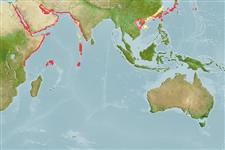>
Ovalentaria/misc (Various families in series Ovalentaria) >
Pomacentridae (Damselfishes) > Pomacentrinae
Etymology: Amphiprion: Greek, amphi = on both sides + Greek, prion, -onos = saw (Ref. 45335).
More on author: Rüppell.
Environment: milieu / Klimaatzone / Diepte / distribution range
Ecologie
marien rifbewoner; standvastig; diepte 1 - 30 m (Ref. 9710). Tropical; 31°N - 7°S
Western Indian Ocean: Red Sea and Chagos Archipelago.
Grootte / Gewicht / Leeftijd
Maturiteit: Lm ? range ? - ? cm
Max length : 14.0 cm TL mannelijk / geslacht onbekend; (Ref. 9710)
Korte beschrijving
Determinatiesleutels | Morfologie | Morfometrie
Dorsale stekels (totaal) : 9 - 10; Dorsale zachte stralen (totaal) : 15 - 17; Anale stekels: 2; Anale zachte stralen: 13 - 14. Yellow orange with 2 black-edged white bands, the first running just behind the head, the second from the notch between the spinous and soft dorsal fin to the abdomen.
Body shape (shape guide): short and / or deep; Cross section: compressed.
Levenscyclus en paargedrag
Maturiteit | Voortplanting | Paaien | Eieren | Fecunditeit | Larven
Oviparous, distinct pairing during breeding (Ref. 205). Monogamous mating is observed as both obligate and social (Ref. 52884). Eggs are demersal and adhere to the substrate (Ref. 205). Males guard and aerate the eggs (Ref. 205). Sex reversal is completed in 26-145 days (Ref. 34185). In a field test, a functional male laid eggs in 26 days after removal of the female from the area (Ref. 240, 32167).
Allen, G.R., 1991. Damselfishes of the world. Mergus Publishers, Melle, Germany. 271 p. (Ref. 7247)
Status op de Rode Lijst van het IUCN (Ref. 130435: Version 2025-1)
Gevaar voor de mens
Harmless
Gebruik door de mens
Visserij: commercieel; Aquarium: Commercieel
Tools
Speciale rapporten
Download XML
Internetbronnen
Estimates based on models
Preferred temperature (Ref.
123201): 24.6 - 29.1, mean 27.4 °C (based on 589 cells).
Fylogenetische diversiteitsindex (Ref.
82804): PD
50 = 0.5000 [Uniqueness, from 0.5 = low to 2.0 = high].
Bayesian length-weight: a=0.02344 (0.01134 - 0.04848), b=2.98 (2.80 - 3.16), in cm total length, based on LWR estimates for this (Sub)family-body shape (Ref.
93245).
Trofisch niveau (Ref.
69278): 2.7 ±0.30 se; based on food items.
Weerstandsvermogen (Ref.
120179): Hoog, minimale populatieverdubbelingstijd minder dan 15 maanden (Preliminary K or Fecundity.).
Fishing Vulnerability (Ref.
59153): Low vulnerability (10 of 100).
🛈
Nutrients (Ref.
124155): Calcium = 93.7 [47.6, 145.6] mg/100g; Iron = 0.71 [0.44, 1.15] mg/100g; Protein = 18.2 [17.1, 19.4] %; Omega3 = 0.109 [0.069, 0.174] g/100g; Selenium = 25.1 [14.3, 45.9] μg/100g; VitaminA = 80.2 [22.4, 269.2] μg/100g; Zinc = 1.63 [1.12, 2.34] mg/100g (wet weight);
